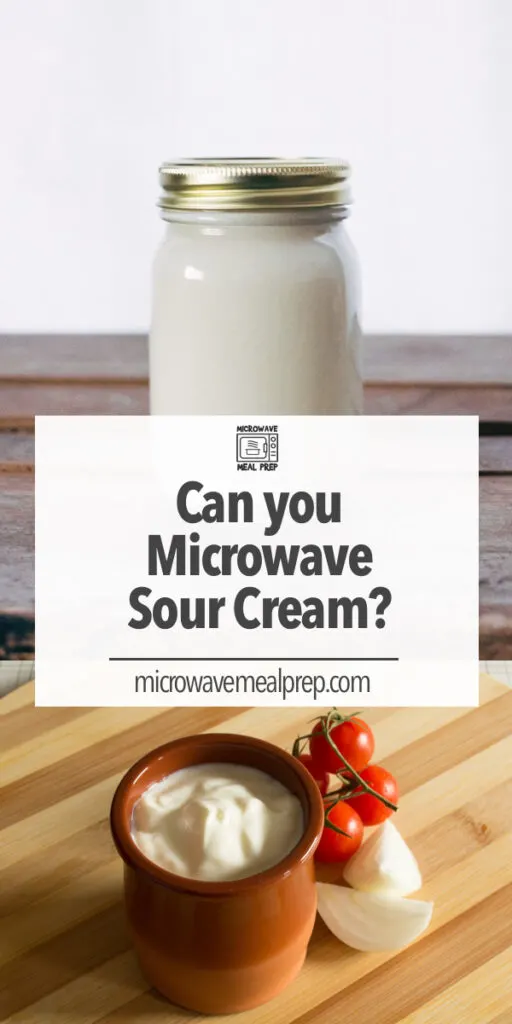Sour cream is a condiment that makes everything from dips to burritos and baked potatoes taste even better. It can be difficult to completely separate the layers between your leftovers, so can you microwave sour cream?
Yes, you can microwave sour cream. From full-fat to fat-free, the cooking time and power level that you microwave sour cream is ultimately determined by the end results you are looking for.
In general, you want to avoid sour cream curdling or separating when heated in the microwave. Also, you want to prevent chemicals from leaching into the sour cream when using non-microwave safe containers.
Sour cream is made by combining lactic acid-producing bacteria with dairy cream. But, is it safe to heat sour cream in the microwave?
Is it safe to eat warm sour cream?
Depending on how the sour cream is handled and stored can totally change the scope of safety. According to the USDA temperature danger zone guidelines, dairy products are considered to be perishable food items that need to be refrigerated or frozen within 2 hours.
The USDA safe handling procedures considers sour cream to be a perishable food that should not sit out at room temperature for longer than 4 hours. If the sour cream is left out in temperature warmer than 90 degree Fahrenheit, the harmful pathogens multiply very quickly and the fermented cream will spoil.
When sour cream is microwaved inside food, then it should be safe to heat and consume.
However, if sour cream has been sitting at room temperature above 40 degrees Fahrenheit for longer than two hours, there is a chance developed harmful spoiled microorganisms. Sour cream that has been left at room temperature for longer than 4 hours should be thrown away.
Although the sour cream may look visibly ok, you could get food poisoning so don’t take a chance.
When properly refrigerated, sour cream can last up to two weeks longer than the best by date on the container. Evidence of mold or unpleasant odors are signs of spoilage and the sour cream should be discarded right away.
Can you reheat leftovers with sour cream?
It is nearly impossible to separate layers of sour cream inside leftover bowls and burritos. So, can sour cream be reheated when it is mixed into leftover food?
The good news is that you can reheat leftovers that contain sour cream. However, microwaving leftovers with sour cream inside can turn into a soggy mess.
When in doubt, scoop out what you can. Then proceed to reheat the food in the microwave and add the sour cream afterwards.
How to heat sour cream in the microwave?
In certain recipes such as dipping sauce, garlic marinated chicken breasts or gravy sauce, sour cream is a prominent ingredients.
When heating sour cream in the microwave, you should never use the original container. The plastic containers are not microwave safe and may release harmful chemicals into sour cream when heated.
Use a microwave-safe dish such as a glass dish or ceramic bowl.
For best results, reheat one or two tablespoons at a time. Large amounts of sour cream may overheat and curdle or separate very quickly.
In general, a good rule of thumb to follow is use medium power level and nuke 15 seconds for each tablespoon of sour cream. Stop and stir every 5 seconds to evenly distribute the heat.
Also, be aware that some types of sour cream produce different results when heated in the microwave. For example, full-fat and reduced-fat sour cream heat more consistently than non-fat varieties.
If you need to heat a low-fat or non-fat sour cream, pay close attention to heat levels to avoid overheating that will inevitably cause curdling and separation.
Things you need to know before microwaving sour cream
Sour cream has a tendency to blend into different layers of food, so it can be difficult to separate the condiment or topping from you leftovers. Microwaving sour cream can be a quick short cut when reheating leftover meals.
The main issue you need to be careful of when microwaving sour cream is curdling and separation. Start with low power level and heat slowly to decrease the chance of coagulation.
For more reheating tips, here are things you need to know before microwaving sour cream in your next meal prep:
- If sour cream is difficult to scoop out of your leftover, leave it inside the dish and just add some extra on the side for a cold creamy topping.
- Minimize splatter by placing a paper towel or microwave cover over the container when reheating.
- Divide the sour cream into smaller portions to heat individual portions when warming large amounts.
- Do not use the original plastic container in the microwave. Instead use a microwave-safe container to heat up food.
- Never reheat sour cream that has already been reheated once before.
- Reduce the power setting to low or medium power level when reheating food in the microwave.
Reheating your favorite foods containing sour cream can be a bit tricky. Depending on how much is inside, the results can be a soggy mess.
Because sour cream isn’t heat-stable, it can make it difficult to successfully reheat food once its been added. Treat each food differently to carefully heat your leftover in the microwave so that you avoid any curdling or coagulation.


